Analyzing Growth, Succession, and Exit Strategies for MOMA Foods
VerifiedAdded on 2022/12/22
|9
|2462
|92
Report
AI Summary
This report examines the growth strategies, exit strategies, and challenges faced by MOMA Foods, a small enterprise owned by Tom Mercer. It explores various exit strategies like liquidation and selling the business, considering factors such as financial stability and market conditions. The report also delves into growth and succession planning in family businesses, highlighting the importance of leadership and professional advice. It analyzes internal and external factors that can lead to business failures, including economic changes, legal regulations, and internal management issues. Furthermore, it discusses the impact of cultural conflicts on business operations and the need for adaptability. Finally, it emphasizes the importance of creating an exit strategy and the challenges entrepreneurs face when quitting their businesses. The report concludes that businesses need a good business plan to overcome the challenges and to achieve growth.
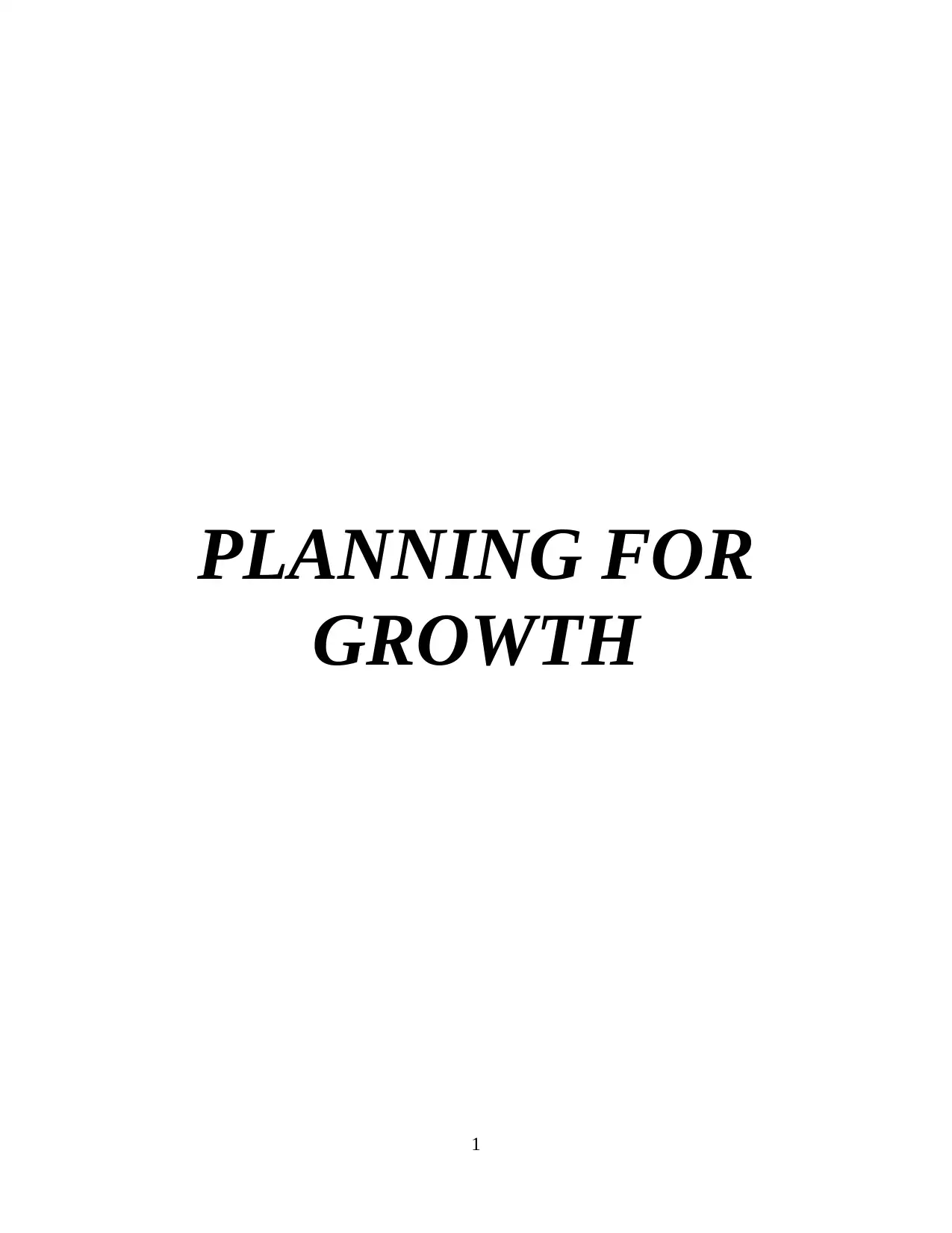
PLANNING FOR
GROWTH
1
GROWTH
1
Paraphrase This Document
Need a fresh take? Get an instant paraphrase of this document with our AI Paraphraser
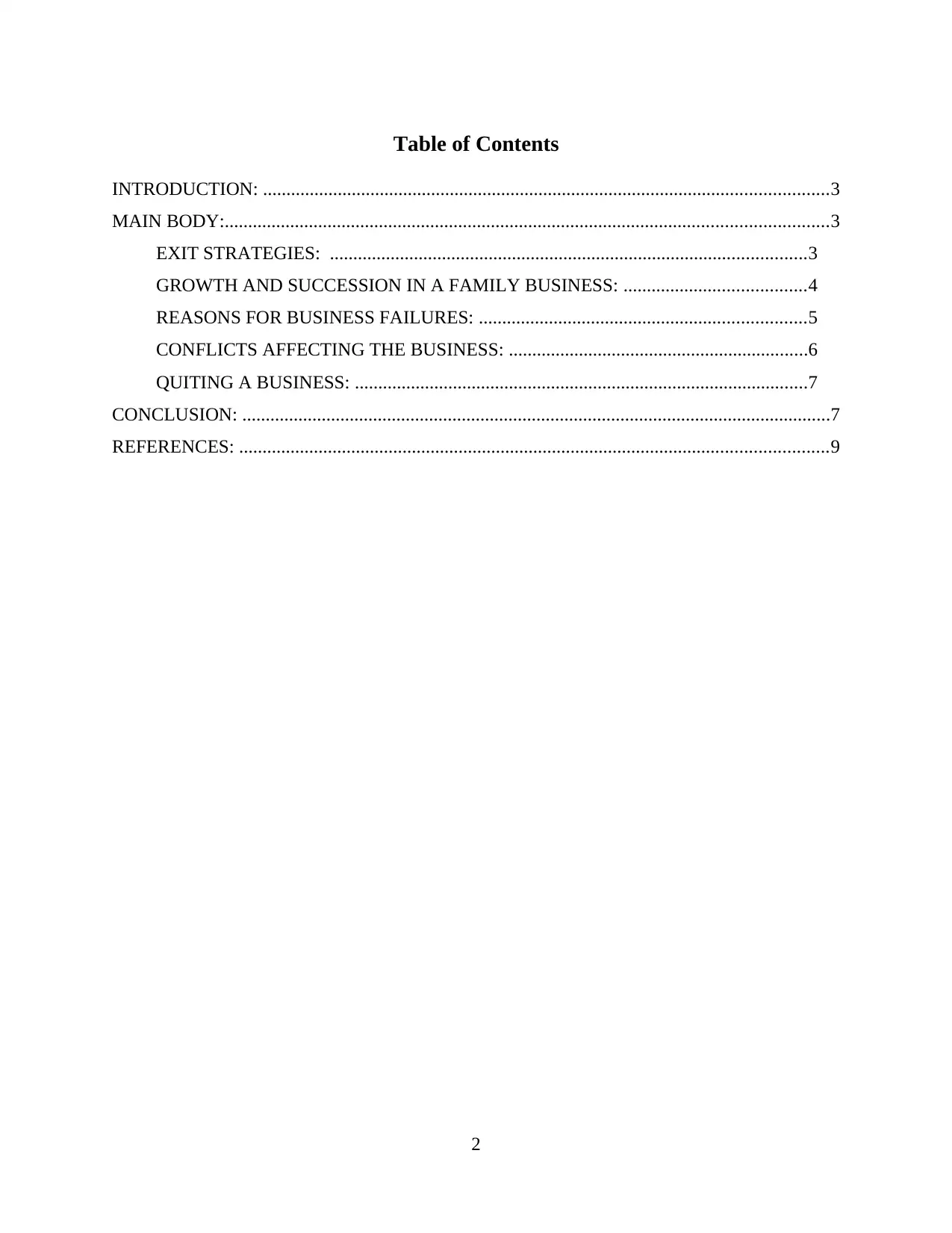
Table of Contents
INTRODUCTION: .........................................................................................................................3
MAIN BODY:.................................................................................................................................3
EXIT STRATEGIES: ......................................................................................................3
GROWTH AND SUCCESSION IN A FAMILY BUSINESS: .......................................4
REASONS FOR BUSINESS FAILURES: ......................................................................5
CONFLICTS AFFECTING THE BUSINESS: ................................................................6
QUITING A BUSINESS: .................................................................................................7
CONCLUSION: ..............................................................................................................................7
REFERENCES: ..............................................................................................................................9
2
INTRODUCTION: .........................................................................................................................3
MAIN BODY:.................................................................................................................................3
EXIT STRATEGIES: ......................................................................................................3
GROWTH AND SUCCESSION IN A FAMILY BUSINESS: .......................................4
REASONS FOR BUSINESS FAILURES: ......................................................................5
CONFLICTS AFFECTING THE BUSINESS: ................................................................6
QUITING A BUSINESS: .................................................................................................7
CONCLUSION: ..............................................................................................................................7
REFERENCES: ..............................................................................................................................9
2
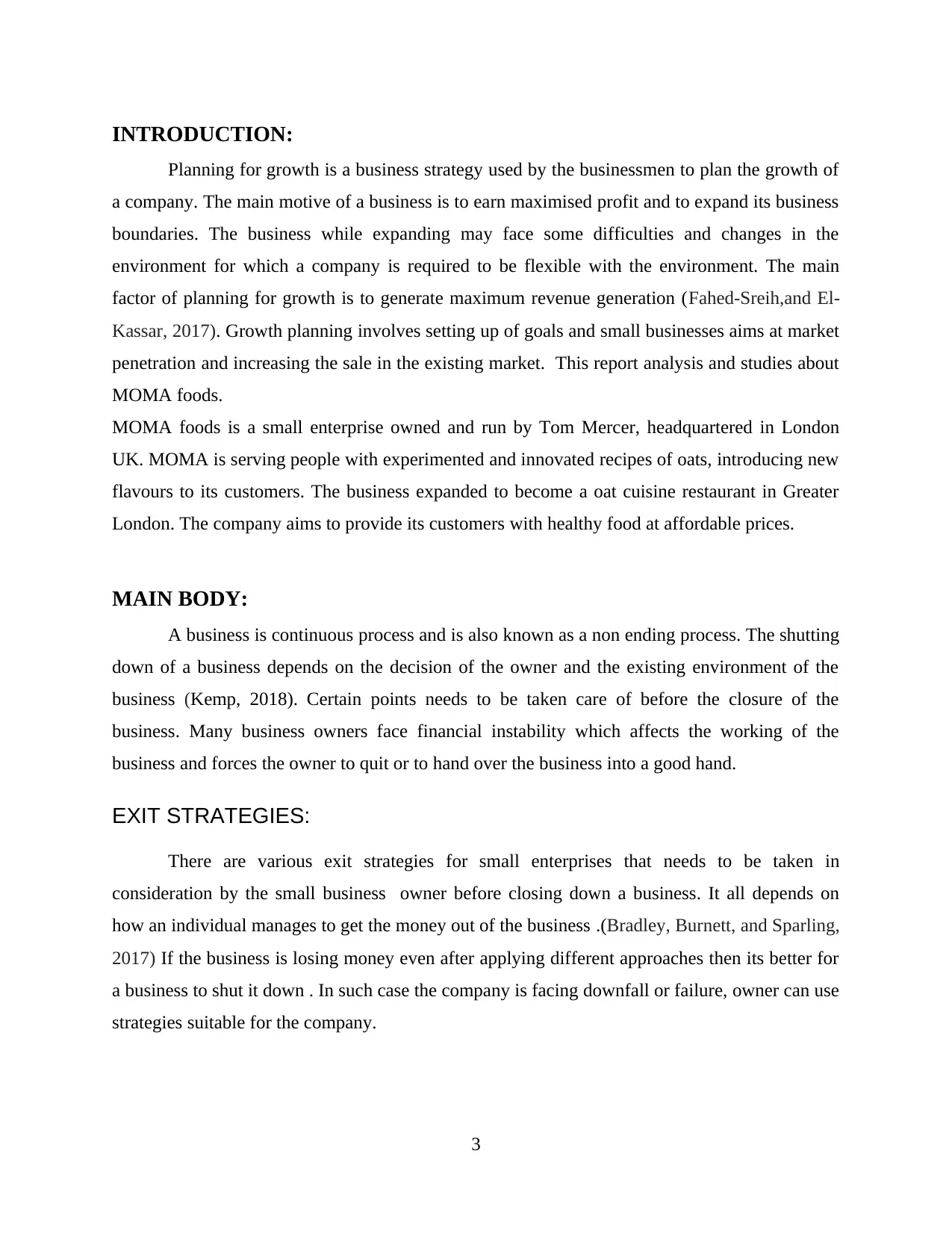
INTRODUCTION:
Planning for growth is a business strategy used by the businessmen to plan the growth of
a company. The main motive of a business is to earn maximised profit and to expand its business
boundaries. The business while expanding may face some difficulties and changes in the
environment for which a company is required to be flexible with the environment. The main
factor of planning for growth is to generate maximum revenue generation (Fahed-Sreih,and El-
Kassar, 2017). Growth planning involves setting up of goals and small businesses aims at market
penetration and increasing the sale in the existing market. This report analysis and studies about
MOMA foods.
MOMA foods is a small enterprise owned and run by Tom Mercer, headquartered in London
UK. MOMA is serving people with experimented and innovated recipes of oats, introducing new
flavours to its customers. The business expanded to become a oat cuisine restaurant in Greater
London. The company aims to provide its customers with healthy food at affordable prices.
MAIN BODY:
A business is continuous process and is also known as a non ending process. The shutting
down of a business depends on the decision of the owner and the existing environment of the
business (Kemp, 2018). Certain points needs to be taken care of before the closure of the
business. Many business owners face financial instability which affects the working of the
business and forces the owner to quit or to hand over the business into a good hand.
EXIT STRATEGIES:
There are various exit strategies for small enterprises that needs to be taken in
consideration by the small business owner before closing down a business. It all depends on
how an individual manages to get the money out of the business .(Bradley, Burnett, and Sparling,
2017) If the business is losing money even after applying different approaches then its better for
a business to shut it down . In such case the company is facing downfall or failure, owner can use
strategies suitable for the company.
3
Planning for growth is a business strategy used by the businessmen to plan the growth of
a company. The main motive of a business is to earn maximised profit and to expand its business
boundaries. The business while expanding may face some difficulties and changes in the
environment for which a company is required to be flexible with the environment. The main
factor of planning for growth is to generate maximum revenue generation (Fahed-Sreih,and El-
Kassar, 2017). Growth planning involves setting up of goals and small businesses aims at market
penetration and increasing the sale in the existing market. This report analysis and studies about
MOMA foods.
MOMA foods is a small enterprise owned and run by Tom Mercer, headquartered in London
UK. MOMA is serving people with experimented and innovated recipes of oats, introducing new
flavours to its customers. The business expanded to become a oat cuisine restaurant in Greater
London. The company aims to provide its customers with healthy food at affordable prices.
MAIN BODY:
A business is continuous process and is also known as a non ending process. The shutting
down of a business depends on the decision of the owner and the existing environment of the
business (Kemp, 2018). Certain points needs to be taken care of before the closure of the
business. Many business owners face financial instability which affects the working of the
business and forces the owner to quit or to hand over the business into a good hand.
EXIT STRATEGIES:
There are various exit strategies for small enterprises that needs to be taken in
consideration by the small business owner before closing down a business. It all depends on
how an individual manages to get the money out of the business .(Bradley, Burnett, and Sparling,
2017) If the business is losing money even after applying different approaches then its better for
a business to shut it down . In such case the company is facing downfall or failure, owner can use
strategies suitable for the company.
3
⊘ This is a preview!⊘
Do you want full access?
Subscribe today to unlock all pages.

Trusted by 1+ million students worldwide
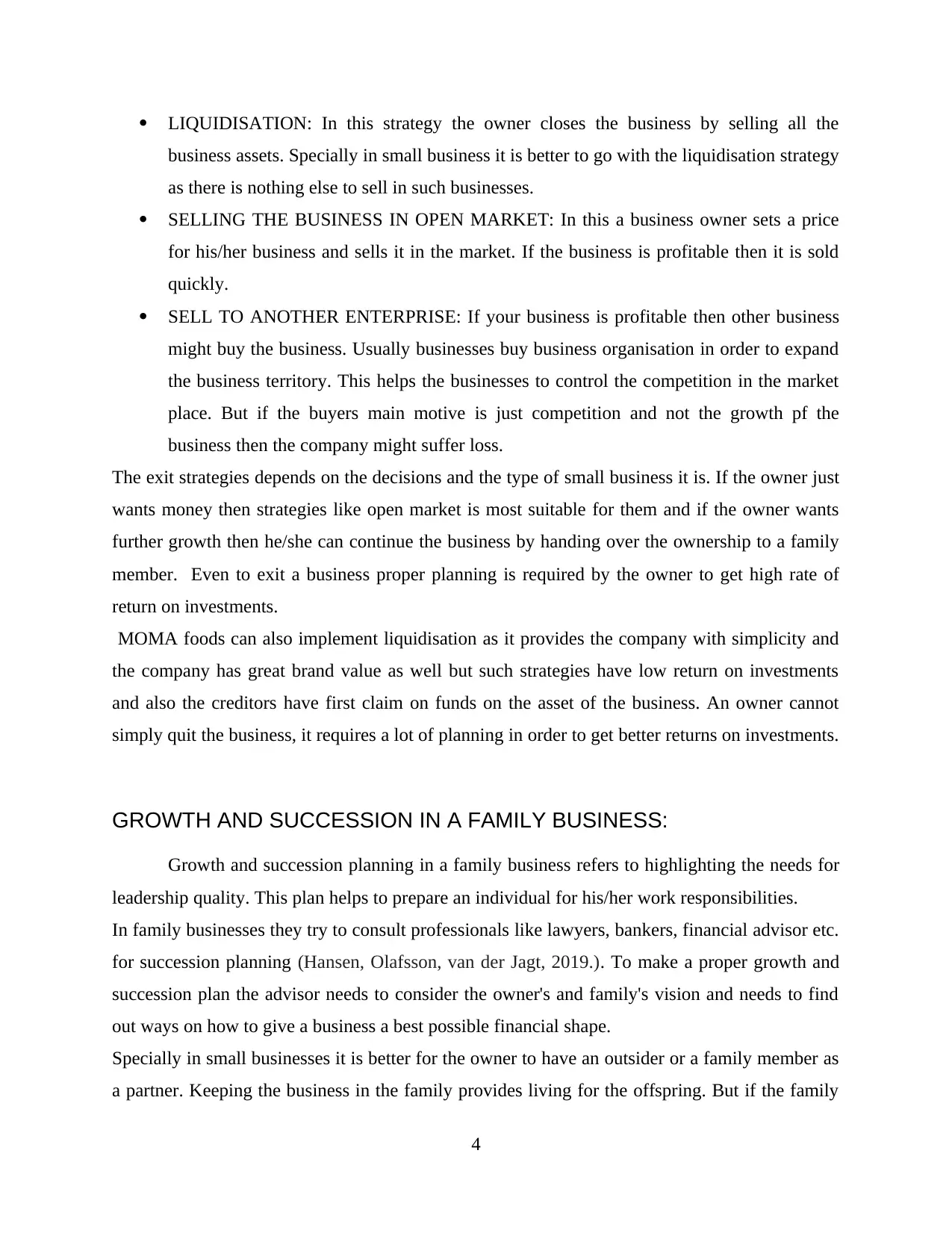
LIQUIDISATION: In this strategy the owner closes the business by selling all the
business assets. Specially in small business it is better to go with the liquidisation strategy
as there is nothing else to sell in such businesses.
SELLING THE BUSINESS IN OPEN MARKET: In this a business owner sets a price
for his/her business and sells it in the market. If the business is profitable then it is sold
quickly.
SELL TO ANOTHER ENTERPRISE: If your business is profitable then other business
might buy the business. Usually businesses buy business organisation in order to expand
the business territory. This helps the businesses to control the competition in the market
place. But if the buyers main motive is just competition and not the growth pf the
business then the company might suffer loss.
The exit strategies depends on the decisions and the type of small business it is. If the owner just
wants money then strategies like open market is most suitable for them and if the owner wants
further growth then he/she can continue the business by handing over the ownership to a family
member. Even to exit a business proper planning is required by the owner to get high rate of
return on investments.
MOMA foods can also implement liquidisation as it provides the company with simplicity and
the company has great brand value as well but such strategies have low return on investments
and also the creditors have first claim on funds on the asset of the business. An owner cannot
simply quit the business, it requires a lot of planning in order to get better returns on investments.
GROWTH AND SUCCESSION IN A FAMILY BUSINESS:
Growth and succession planning in a family business refers to highlighting the needs for
leadership quality. This plan helps to prepare an individual for his/her work responsibilities.
In family businesses they try to consult professionals like lawyers, bankers, financial advisor etc.
for succession planning (Hansen, Olafsson, van der Jagt, 2019.). To make a proper growth and
succession plan the advisor needs to consider the owner's and family's vision and needs to find
out ways on how to give a business a best possible financial shape.
Specially in small businesses it is better for the owner to have an outsider or a family member as
a partner. Keeping the business in the family provides living for the offspring. But if the family
4
business assets. Specially in small business it is better to go with the liquidisation strategy
as there is nothing else to sell in such businesses.
SELLING THE BUSINESS IN OPEN MARKET: In this a business owner sets a price
for his/her business and sells it in the market. If the business is profitable then it is sold
quickly.
SELL TO ANOTHER ENTERPRISE: If your business is profitable then other business
might buy the business. Usually businesses buy business organisation in order to expand
the business territory. This helps the businesses to control the competition in the market
place. But if the buyers main motive is just competition and not the growth pf the
business then the company might suffer loss.
The exit strategies depends on the decisions and the type of small business it is. If the owner just
wants money then strategies like open market is most suitable for them and if the owner wants
further growth then he/she can continue the business by handing over the ownership to a family
member. Even to exit a business proper planning is required by the owner to get high rate of
return on investments.
MOMA foods can also implement liquidisation as it provides the company with simplicity and
the company has great brand value as well but such strategies have low return on investments
and also the creditors have first claim on funds on the asset of the business. An owner cannot
simply quit the business, it requires a lot of planning in order to get better returns on investments.
GROWTH AND SUCCESSION IN A FAMILY BUSINESS:
Growth and succession planning in a family business refers to highlighting the needs for
leadership quality. This plan helps to prepare an individual for his/her work responsibilities.
In family businesses they try to consult professionals like lawyers, bankers, financial advisor etc.
for succession planning (Hansen, Olafsson, van der Jagt, 2019.). To make a proper growth and
succession plan the advisor needs to consider the owner's and family's vision and needs to find
out ways on how to give a business a best possible financial shape.
Specially in small businesses it is better for the owner to have an outsider or a family member as
a partner. Keeping the business in the family provides living for the offspring. But if the family
4
Paraphrase This Document
Need a fresh take? Get an instant paraphrase of this document with our AI Paraphraser
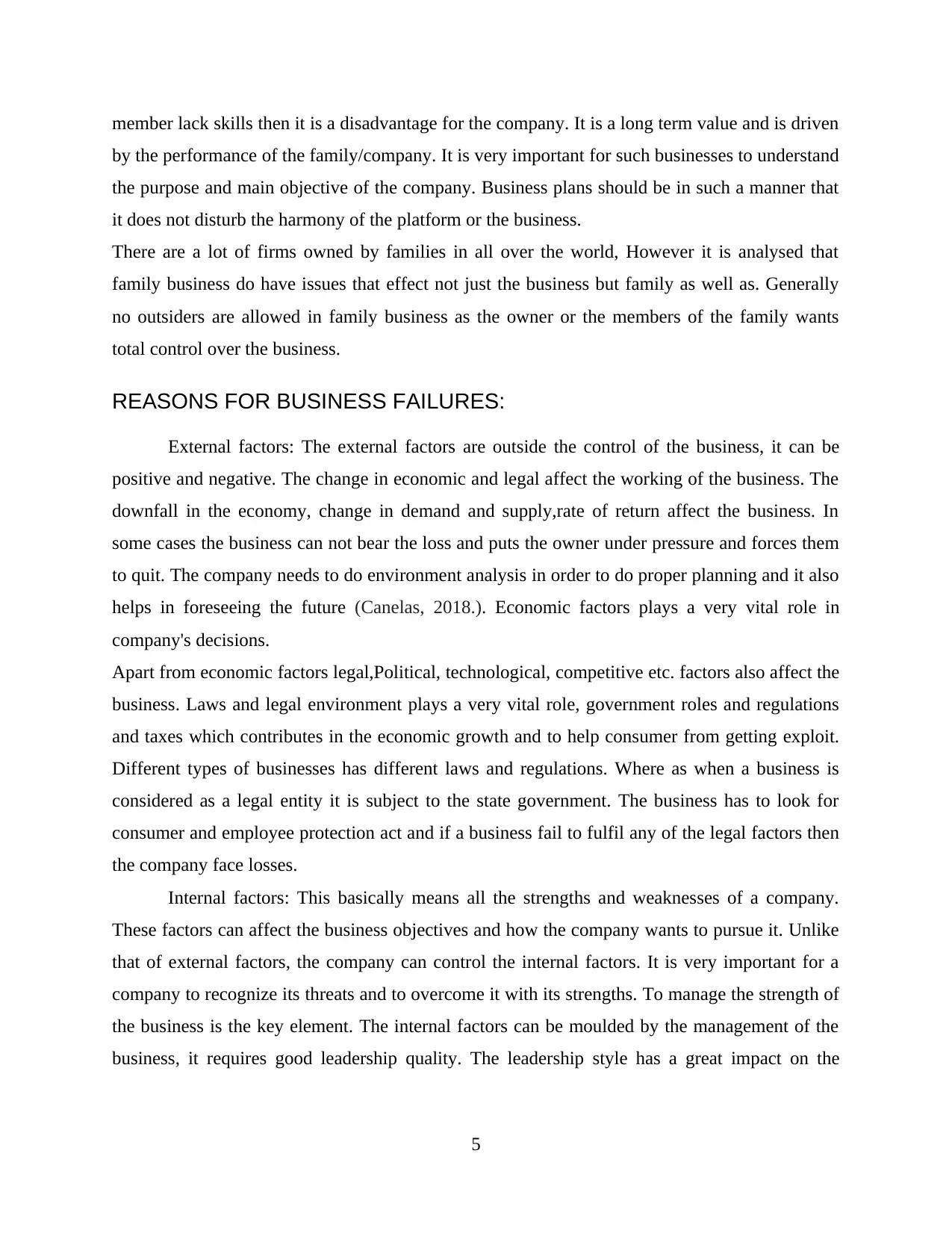
member lack skills then it is a disadvantage for the company. It is a long term value and is driven
by the performance of the family/company. It is very important for such businesses to understand
the purpose and main objective of the company. Business plans should be in such a manner that
it does not disturb the harmony of the platform or the business.
There are a lot of firms owned by families in all over the world, However it is analysed that
family business do have issues that effect not just the business but family as well as. Generally
no outsiders are allowed in family business as the owner or the members of the family wants
total control over the business.
REASONS FOR BUSINESS FAILURES:
External factors: The external factors are outside the control of the business, it can be
positive and negative. The change in economic and legal affect the working of the business. The
downfall in the economy, change in demand and supply,rate of return affect the business. In
some cases the business can not bear the loss and puts the owner under pressure and forces them
to quit. The company needs to do environment analysis in order to do proper planning and it also
helps in foreseeing the future (Canelas, 2018.). Economic factors plays a very vital role in
company's decisions.
Apart from economic factors legal,Political, technological, competitive etc. factors also affect the
business. Laws and legal environment plays a very vital role, government roles and regulations
and taxes which contributes in the economic growth and to help consumer from getting exploit.
Different types of businesses has different laws and regulations. Where as when a business is
considered as a legal entity it is subject to the state government. The business has to look for
consumer and employee protection act and if a business fail to fulfil any of the legal factors then
the company face losses.
Internal factors: This basically means all the strengths and weaknesses of a company.
These factors can affect the business objectives and how the company wants to pursue it. Unlike
that of external factors, the company can control the internal factors. It is very important for a
company to recognize its threats and to overcome it with its strengths. To manage the strength of
the business is the key element. The internal factors can be moulded by the management of the
business, it requires good leadership quality. The leadership style has a great impact on the
5
by the performance of the family/company. It is very important for such businesses to understand
the purpose and main objective of the company. Business plans should be in such a manner that
it does not disturb the harmony of the platform or the business.
There are a lot of firms owned by families in all over the world, However it is analysed that
family business do have issues that effect not just the business but family as well as. Generally
no outsiders are allowed in family business as the owner or the members of the family wants
total control over the business.
REASONS FOR BUSINESS FAILURES:
External factors: The external factors are outside the control of the business, it can be
positive and negative. The change in economic and legal affect the working of the business. The
downfall in the economy, change in demand and supply,rate of return affect the business. In
some cases the business can not bear the loss and puts the owner under pressure and forces them
to quit. The company needs to do environment analysis in order to do proper planning and it also
helps in foreseeing the future (Canelas, 2018.). Economic factors plays a very vital role in
company's decisions.
Apart from economic factors legal,Political, technological, competitive etc. factors also affect the
business. Laws and legal environment plays a very vital role, government roles and regulations
and taxes which contributes in the economic growth and to help consumer from getting exploit.
Different types of businesses has different laws and regulations. Where as when a business is
considered as a legal entity it is subject to the state government. The business has to look for
consumer and employee protection act and if a business fail to fulfil any of the legal factors then
the company face losses.
Internal factors: This basically means all the strengths and weaknesses of a company.
These factors can affect the business objectives and how the company wants to pursue it. Unlike
that of external factors, the company can control the internal factors. It is very important for a
company to recognize its threats and to overcome it with its strengths. To manage the strength of
the business is the key element. The internal factors can be moulded by the management of the
business, it requires good leadership quality. The leadership style has a great impact on the
5
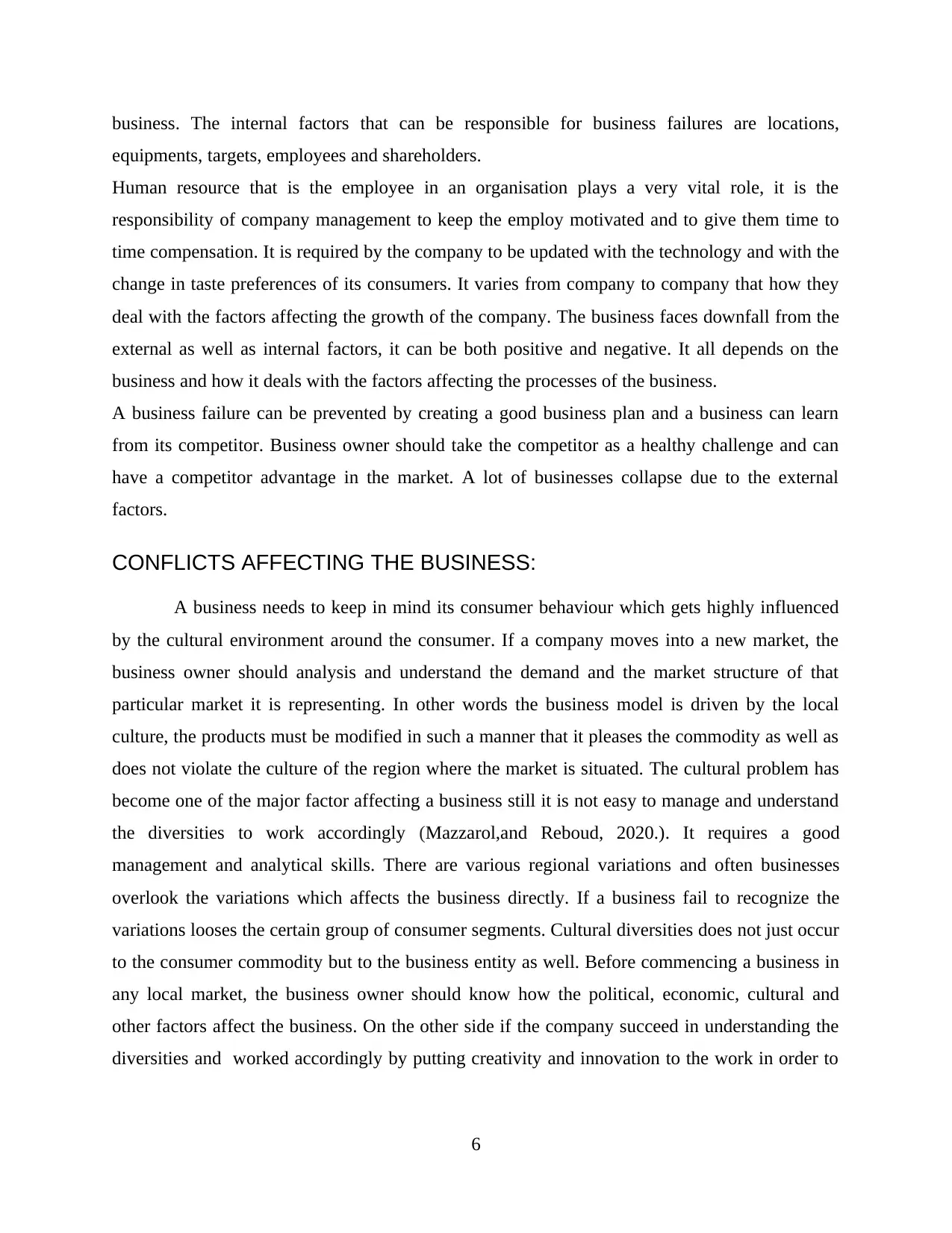
business. The internal factors that can be responsible for business failures are locations,
equipments, targets, employees and shareholders.
Human resource that is the employee in an organisation plays a very vital role, it is the
responsibility of company management to keep the employ motivated and to give them time to
time compensation. It is required by the company to be updated with the technology and with the
change in taste preferences of its consumers. It varies from company to company that how they
deal with the factors affecting the growth of the company. The business faces downfall from the
external as well as internal factors, it can be both positive and negative. It all depends on the
business and how it deals with the factors affecting the processes of the business.
A business failure can be prevented by creating a good business plan and a business can learn
from its competitor. Business owner should take the competitor as a healthy challenge and can
have a competitor advantage in the market. A lot of businesses collapse due to the external
factors.
CONFLICTS AFFECTING THE BUSINESS:
A business needs to keep in mind its consumer behaviour which gets highly influenced
by the cultural environment around the consumer. If a company moves into a new market, the
business owner should analysis and understand the demand and the market structure of that
particular market it is representing. In other words the business model is driven by the local
culture, the products must be modified in such a manner that it pleases the commodity as well as
does not violate the culture of the region where the market is situated. The cultural problem has
become one of the major factor affecting a business still it is not easy to manage and understand
the diversities to work accordingly (Mazzarol,and Reboud, 2020.). It requires a good
management and analytical skills. There are various regional variations and often businesses
overlook the variations which affects the business directly. If a business fail to recognize the
variations looses the certain group of consumer segments. Cultural diversities does not just occur
to the consumer commodity but to the business entity as well. Before commencing a business in
any local market, the business owner should know how the political, economic, cultural and
other factors affect the business. On the other side if the company succeed in understanding the
diversities and worked accordingly by putting creativity and innovation to the work in order to
6
equipments, targets, employees and shareholders.
Human resource that is the employee in an organisation plays a very vital role, it is the
responsibility of company management to keep the employ motivated and to give them time to
time compensation. It is required by the company to be updated with the technology and with the
change in taste preferences of its consumers. It varies from company to company that how they
deal with the factors affecting the growth of the company. The business faces downfall from the
external as well as internal factors, it can be both positive and negative. It all depends on the
business and how it deals with the factors affecting the processes of the business.
A business failure can be prevented by creating a good business plan and a business can learn
from its competitor. Business owner should take the competitor as a healthy challenge and can
have a competitor advantage in the market. A lot of businesses collapse due to the external
factors.
CONFLICTS AFFECTING THE BUSINESS:
A business needs to keep in mind its consumer behaviour which gets highly influenced
by the cultural environment around the consumer. If a company moves into a new market, the
business owner should analysis and understand the demand and the market structure of that
particular market it is representing. In other words the business model is driven by the local
culture, the products must be modified in such a manner that it pleases the commodity as well as
does not violate the culture of the region where the market is situated. The cultural problem has
become one of the major factor affecting a business still it is not easy to manage and understand
the diversities to work accordingly (Mazzarol,and Reboud, 2020.). It requires a good
management and analytical skills. There are various regional variations and often businesses
overlook the variations which affects the business directly. If a business fail to recognize the
variations looses the certain group of consumer segments. Cultural diversities does not just occur
to the consumer commodity but to the business entity as well. Before commencing a business in
any local market, the business owner should know how the political, economic, cultural and
other factors affect the business. On the other side if the company succeed in understanding the
diversities and worked accordingly by putting creativity and innovation to the work in order to
6
⊘ This is a preview!⊘
Do you want full access?
Subscribe today to unlock all pages.

Trusted by 1+ million students worldwide
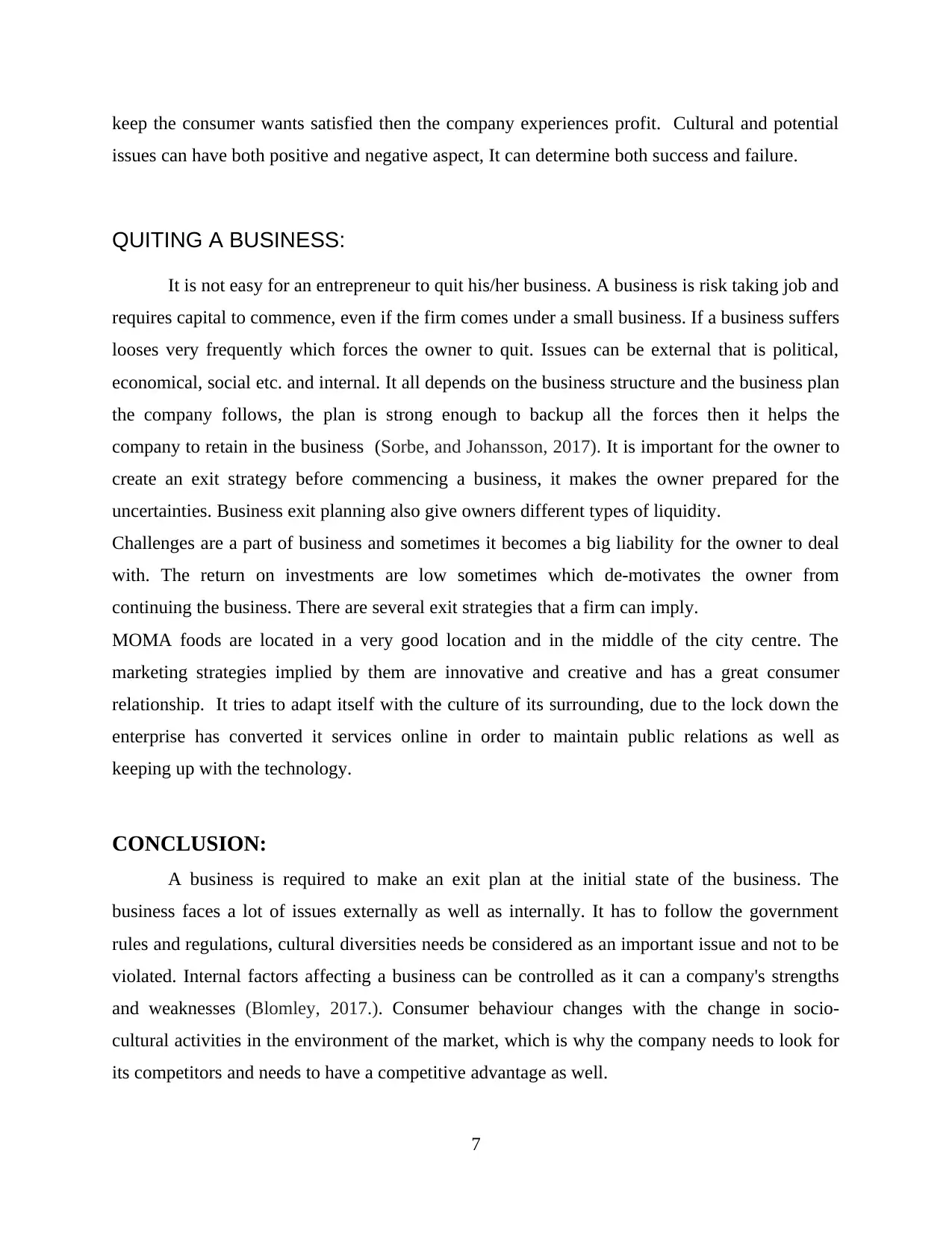
keep the consumer wants satisfied then the company experiences profit. Cultural and potential
issues can have both positive and negative aspect, It can determine both success and failure.
QUITING A BUSINESS:
It is not easy for an entrepreneur to quit his/her business. A business is risk taking job and
requires capital to commence, even if the firm comes under a small business. If a business suffers
looses very frequently which forces the owner to quit. Issues can be external that is political,
economical, social etc. and internal. It all depends on the business structure and the business plan
the company follows, the plan is strong enough to backup all the forces then it helps the
company to retain in the business (Sorbe, and Johansson, 2017). It is important for the owner to
create an exit strategy before commencing a business, it makes the owner prepared for the
uncertainties. Business exit planning also give owners different types of liquidity.
Challenges are a part of business and sometimes it becomes a big liability for the owner to deal
with. The return on investments are low sometimes which de-motivates the owner from
continuing the business. There are several exit strategies that a firm can imply.
MOMA foods are located in a very good location and in the middle of the city centre. The
marketing strategies implied by them are innovative and creative and has a great consumer
relationship. It tries to adapt itself with the culture of its surrounding, due to the lock down the
enterprise has converted it services online in order to maintain public relations as well as
keeping up with the technology.
CONCLUSION:
A business is required to make an exit plan at the initial state of the business. The
business faces a lot of issues externally as well as internally. It has to follow the government
rules and regulations, cultural diversities needs be considered as an important issue and not to be
violated. Internal factors affecting a business can be controlled as it can a company's strengths
and weaknesses (Blomley, 2017.). Consumer behaviour changes with the change in socio-
cultural activities in the environment of the market, which is why the company needs to look for
its competitors and needs to have a competitive advantage as well.
7
issues can have both positive and negative aspect, It can determine both success and failure.
QUITING A BUSINESS:
It is not easy for an entrepreneur to quit his/her business. A business is risk taking job and
requires capital to commence, even if the firm comes under a small business. If a business suffers
looses very frequently which forces the owner to quit. Issues can be external that is political,
economical, social etc. and internal. It all depends on the business structure and the business plan
the company follows, the plan is strong enough to backup all the forces then it helps the
company to retain in the business (Sorbe, and Johansson, 2017). It is important for the owner to
create an exit strategy before commencing a business, it makes the owner prepared for the
uncertainties. Business exit planning also give owners different types of liquidity.
Challenges are a part of business and sometimes it becomes a big liability for the owner to deal
with. The return on investments are low sometimes which de-motivates the owner from
continuing the business. There are several exit strategies that a firm can imply.
MOMA foods are located in a very good location and in the middle of the city centre. The
marketing strategies implied by them are innovative and creative and has a great consumer
relationship. It tries to adapt itself with the culture of its surrounding, due to the lock down the
enterprise has converted it services online in order to maintain public relations as well as
keeping up with the technology.
CONCLUSION:
A business is required to make an exit plan at the initial state of the business. The
business faces a lot of issues externally as well as internally. It has to follow the government
rules and regulations, cultural diversities needs be considered as an important issue and not to be
violated. Internal factors affecting a business can be controlled as it can a company's strengths
and weaknesses (Blomley, 2017.). Consumer behaviour changes with the change in socio-
cultural activities in the environment of the market, which is why the company needs to look for
its competitors and needs to have a competitive advantage as well.
7
Paraphrase This Document
Need a fresh take? Get an instant paraphrase of this document with our AI Paraphraser
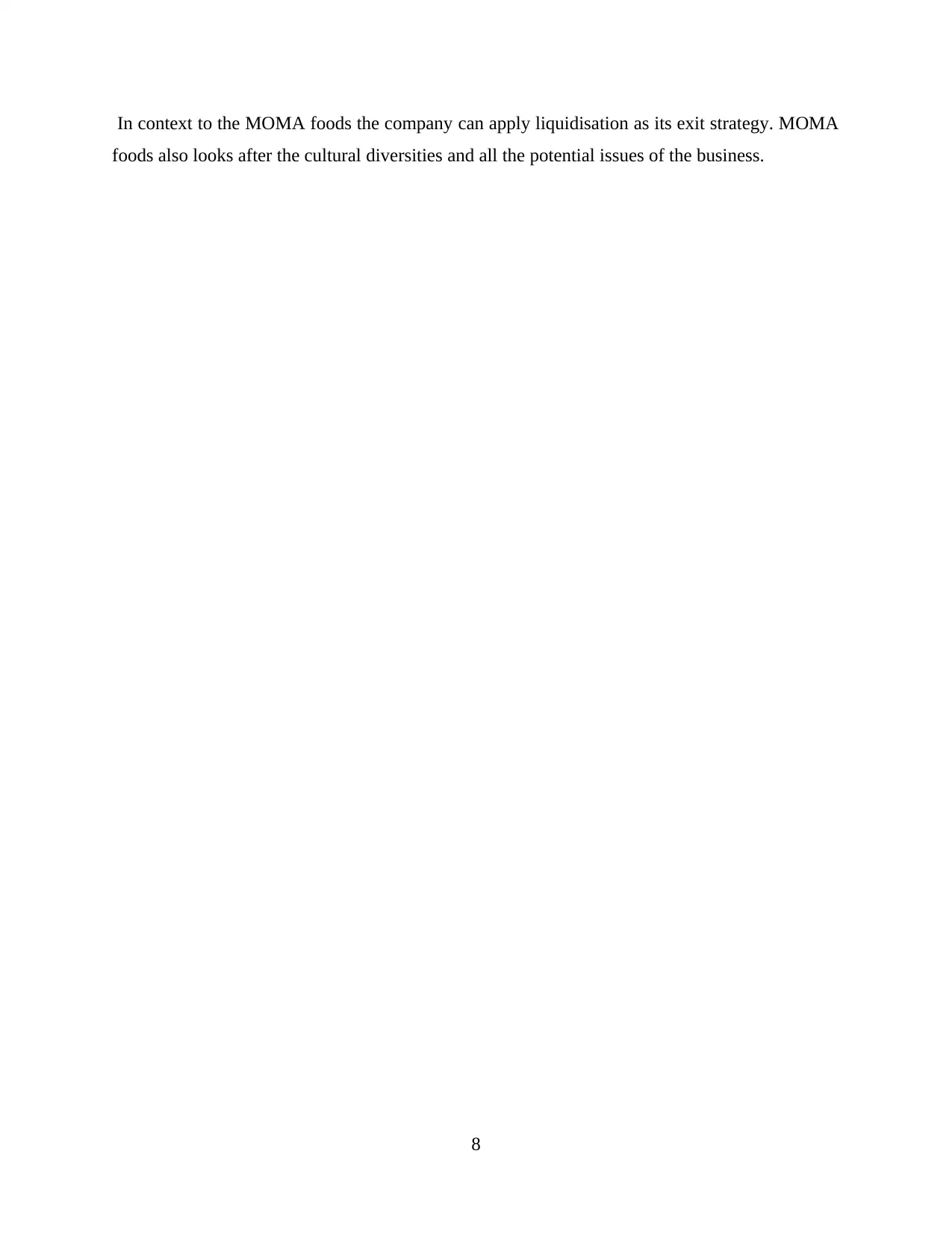
In context to the MOMA foods the company can apply liquidisation as its exit strategy. MOMA
foods also looks after the cultural diversities and all the potential issues of the business.
8
foods also looks after the cultural diversities and all the potential issues of the business.
8
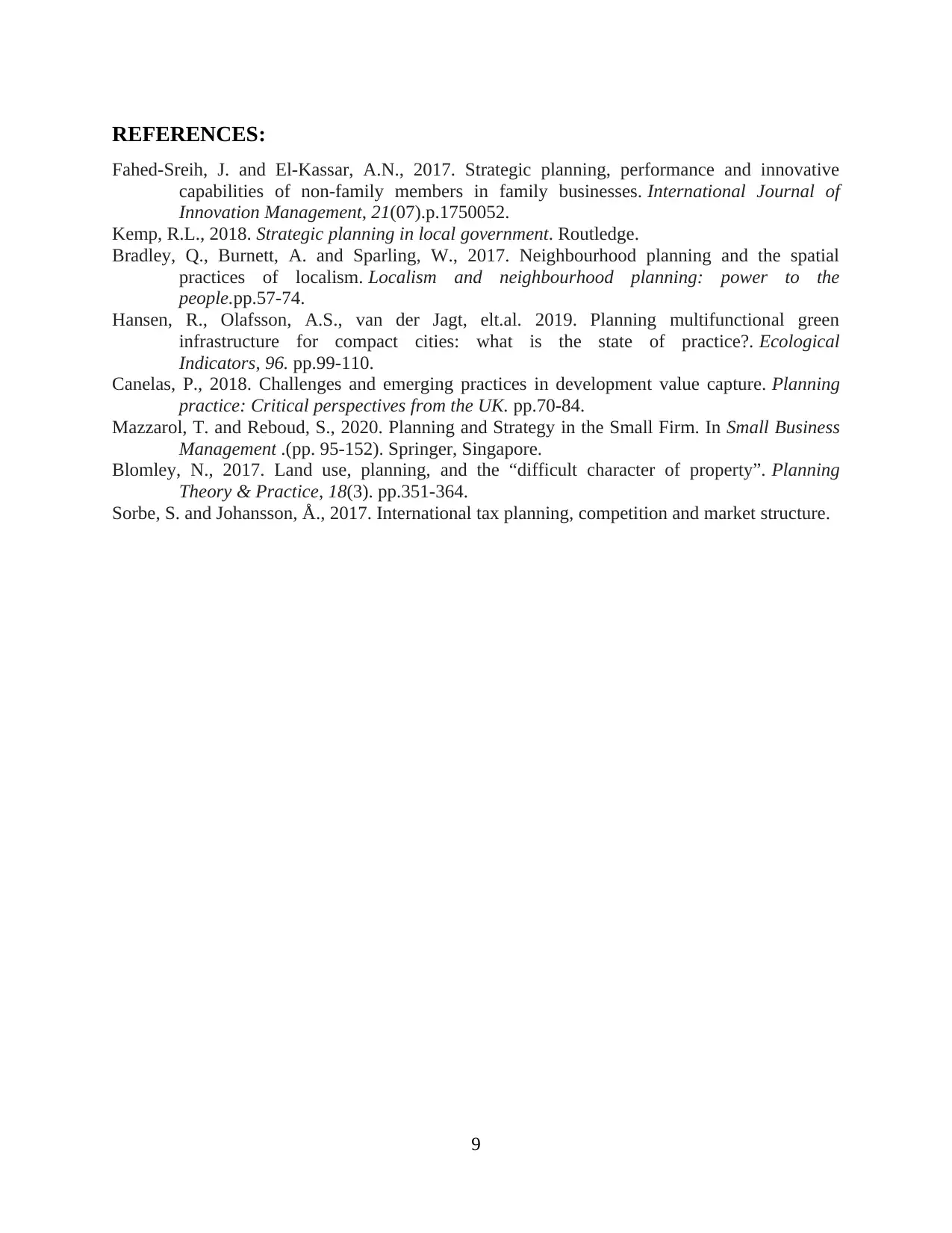
REFERENCES:
Fahed-Sreih, J. and El-Kassar, A.N., 2017. Strategic planning, performance and innovative
capabilities of non-family members in family businesses. International Journal of
Innovation Management, 21(07).p.1750052.
Kemp, R.L., 2018. Strategic planning in local government. Routledge.
Bradley, Q., Burnett, A. and Sparling, W., 2017. Neighbourhood planning and the spatial
practices of localism. Localism and neighbourhood planning: power to the
people.pp.57-74.
Hansen, R., Olafsson, A.S., van der Jagt, elt.al. 2019. Planning multifunctional green
infrastructure for compact cities: what is the state of practice?. Ecological
Indicators, 96. pp.99-110.
Canelas, P., 2018. Challenges and emerging practices in development value capture. Planning
practice: Critical perspectives from the UK. pp.70-84.
Mazzarol, T. and Reboud, S., 2020. Planning and Strategy in the Small Firm. In Small Business
Management .(pp. 95-152). Springer, Singapore.
Blomley, N., 2017. Land use, planning, and the “difficult character of property”. Planning
Theory & Practice, 18(3). pp.351-364.
Sorbe, S. and Johansson, Å., 2017. International tax planning, competition and market structure.
9
Fahed-Sreih, J. and El-Kassar, A.N., 2017. Strategic planning, performance and innovative
capabilities of non-family members in family businesses. International Journal of
Innovation Management, 21(07).p.1750052.
Kemp, R.L., 2018. Strategic planning in local government. Routledge.
Bradley, Q., Burnett, A. and Sparling, W., 2017. Neighbourhood planning and the spatial
practices of localism. Localism and neighbourhood planning: power to the
people.pp.57-74.
Hansen, R., Olafsson, A.S., van der Jagt, elt.al. 2019. Planning multifunctional green
infrastructure for compact cities: what is the state of practice?. Ecological
Indicators, 96. pp.99-110.
Canelas, P., 2018. Challenges and emerging practices in development value capture. Planning
practice: Critical perspectives from the UK. pp.70-84.
Mazzarol, T. and Reboud, S., 2020. Planning and Strategy in the Small Firm. In Small Business
Management .(pp. 95-152). Springer, Singapore.
Blomley, N., 2017. Land use, planning, and the “difficult character of property”. Planning
Theory & Practice, 18(3). pp.351-364.
Sorbe, S. and Johansson, Å., 2017. International tax planning, competition and market structure.
9
⊘ This is a preview!⊘
Do you want full access?
Subscribe today to unlock all pages.

Trusted by 1+ million students worldwide
1 out of 9
Related Documents
Your All-in-One AI-Powered Toolkit for Academic Success.
+13062052269
info@desklib.com
Available 24*7 on WhatsApp / Email
![[object Object]](/_next/static/media/star-bottom.7253800d.svg)
Unlock your academic potential
Copyright © 2020–2025 A2Z Services. All Rights Reserved. Developed and managed by ZUCOL.





